When you buy decking boards, they are already planed on 4 faces (S4S) and usually have the sharp corners eased (E4E). Depending on whether you are face screwing or using a clip system, there may or may not be a groove routed on the edges. This is a product ready to install right? But is it a finished product? Absolutely not, and this is where many homeowners and even contractors get confused and frustrated.
Whether we are talking about Ipe or Cumaru or even Pressure treated Pine or Red Cedar, these decking boards are not intended to be a finished product but rather a building material that requires additional work during installation and throughout its lifespan.
So that everyone has the same expectations, let’s talk about some of the things that can mar that finished product look, and how you can counter them to get the best looking deck possible.
The Ipe Decking Journey

From Forest: Tropical decking boards travel a very long way before they end up in your hands. These boards not only come from trees felled in the Amazon, but they are also sawn into boards in the same area and eventually milled into the S4S, E4E decking board. Following this, the decking boards are loaded onto a truck and driven to a port city, where the decking is loaded into a metal container and put on a ship to go for a very long boat ride.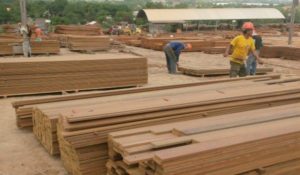
To Ocean: Now think about the moisture content of these boards. As an exterior product, decking is air dried to around 18% moisture content. When the decking is loaded into a metal container, it can be like putting the decking into a kiln as the sun beats down and raises the temperature inside the metal container. At night or when the temperature drops during the ocean transit, the container cools and condensation gathers on the walls of the container; this moisture then drips onto the boards. Then the shipping container heats up again and evaporates the standing water, depositing on the decking whatever minerals or impurities are in the air or on the inside of the container. This leaves water stains, and it is very common to find these stains throughout a pack of lumber that just arrived from a several thousand mile ocean journey.
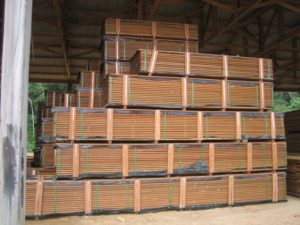
And finally to You: Now consider the job site. This decking will be stacked, sometimes in the dirt, while it waits to be installed on the undercarriage. Even if the decking boards just sit around on the job site, these boards will pick up additional mud and stains. Now imagine if it rains during installation, and the ground gets muddy or the decking is cover with a tarp. Remember that condensation scenario in the container? The tarp can create the same environment. Now think about what takes place once the decking is installed. You or your contractor and crew will be walking across these boards with muddy boots leaving footprints.
Ipe Deck Maintenance
Is it any wonder why we and decking dealers like us don’t clean the mud and grime off our decking before shipping the boards out? We do take pains to present our products in the best light possible, but we also know full well that many things will dirty up the boards after the decking leaves our yard, and we know that any extra work will only add to the cost and lead time on an order. Ultimately, Ipe and Cumaru or decking products like these are NOT finished products. They require additional work downstream from the lumber yard like cleaning and/or sanding.
Sanding Ipe Deck to Remove Rough Spots from Raised Grain
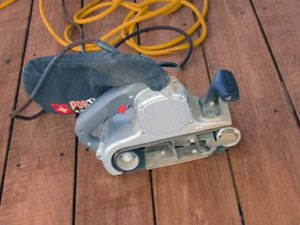
Like our analogy with the cat, wood will fight back when your planer encounters grain going in a different direction, and wood will tear out, creating a rough spot. Remember that wood is organic, and while there is a predominant grain direction, any woodworker will tell you that the grain direction changes often, and you have to stay on your toes and deal with tear out. This tear out is most often found around knots or the swirls in the grain that occur around a knot. Even if your board doesn’t have a knot in it, there may have been one nearby in the log that has caused the grain to jog off in a different direction.
Vertical grain or quartersawn boards will present rough spots as well. The growth rings are now intersecting the wide face of the board at or close to 90 degrees, and grain direction can become a guessing game. Moreover, these fibers are much harder and will often remain raised a tiny bit above the surface of the rest of the board. Deck owners will often complain of this the first time they walk across their new deck in bare feet. Species like Ipe and Cumaru are exceptionally hard too, so these little raised areas can actually be quite painful and even more prominent.
Once again, the lumber yard could sand all the boards before shipping the decking by running the boards through a drum sander; however, this is a wasteful and inefficient solution. Forget about the dirt and grime point above for now, and think about what a drum sander will do to the boards. The drum sander would uniformly reducing the thickness of all of your boards, even the ones that don’t need it, in order to knock down any raised grain. This raised grain could be 10% or 1% of your total deck, yet once we sand 1 board, we have to sand them all so they are the same thickness upon installation.
The more appropriate solution is to sand after the deck is installed. Using something as simple as a hand held belt sander or random orbital sander will knock down those raised sections; while it is reducing the thickness of the board in that one space, it is not noticeable across the whole deck. Here again, decking is not a finished product, and like hardwood flooring, additional sanding and work on site during and after installation is required to get the best looking deck or floor.
After Such a Long Trip, Boards Need Rest
As stated above, tropical decking boards and even domestic decking can travel a really long way to get to your job site. The decking has gone through a myriad of environmental conditions and is just trying to keep up with the changes and trying to find an equilibrium. Not sure why?, use the search bar above and you will find at least 10 articles on wood movement and moisture content.
You must allow time for your decking to acclimate to its surroundings. This may be just a few days – it really depends on the local climate and the journey of that particular lumber. Ideally you should store your decking boards under cover and near where they will be installed so they can come into an equilibrium of sorts with the environment. An installation that is rushed will result in a deck that won’t lay flat and which may crack or buckle later on. So keep this in mind because the chances that you have a few days of free time to just let the decking sit around are very slim. That’s why I say “ideally”. In the end installing your decking following proper spacing will be your best defense against wood movement issues later on. This is not to imply that once acclimated your boards won’t move again, far from it, but starting with a board at rest instead of one which is moving will make any installation go smoother. There will still be some bend and bow in evidence, especially the longer and wider the board is. This is what things like the Hardwood Wrench and other deck installation tools are there for. Perhaps this is not additional work that needs to be done to your decking after it leaves the lumber yard as much as additional time that should be budgeted for the project in order to ensure an easier installation and a more stable deck for years to come.
Ipe Deck Cleaning
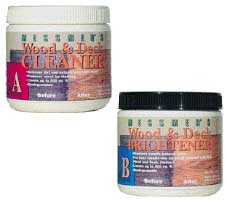
So even after taking into account all of the points above, the single most effective thing you can do to ensure your deck looks its best is to use a deck cleaner and brightener product. There are a lot of these on the market, but essentially the cleaner is a mild abrasive as well as a cleaner that will scour the boards and remove that ground in, baked on dirt and gunk that even a pressure washer won’t get rid of. The brightener product goes on after the deck is clean, and these usually have some kind of acid that will, for lack of a better term, bleach the deck and lighten it and/or remove any graying from UV exposure.
Keep in mind that some of the cheaper products will just use bleach, and this can be harmful to the wood itself and even pose further issues when trying later to apply stains or oils to the deck. The better quality products will use something like citric acid that is much kinder to the wood, and which is not harmful to your plants and soil around and under the deck.
For a new deck installation, once the cleaner is applied, you may well be able to skip the brightener and go right on to oil. It does depend on the state of the boards. If in doubt, let the deck get some sun for a few days, and then see how the color changes after the scrubbing you gave it. The brightener product will aid in blending varying colors on a deck, so it will be up to you whether or not to apply it. Often these brighteners are also used years down the road when a deck needs a refresh. Honestly, this cleaner step gets forgotten a lot, and it perfectly illustrates the point that decking is not a finished product. It is the additional work after the wood is delivered that truly makes your deck beautiful.
J. Gibson McIlvain takes great pride in the quality of our Ipe and Cumaru decking boards, but we also carry deck cleaner and brightener for our customers, because we know that while maybe it isn’t a secret, it is one of the single best things you can do to make your deck beautiful.
Learn more about the lumber industry:

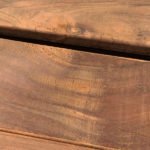
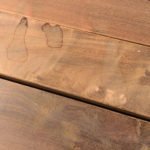
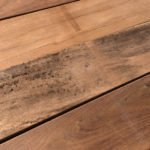
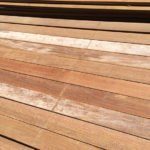
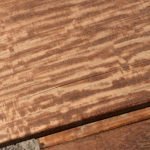
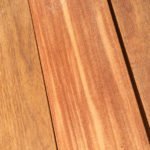
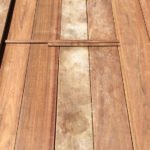
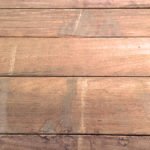
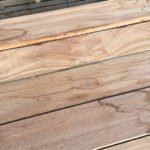
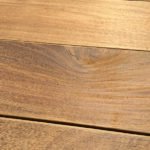

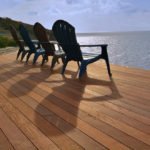
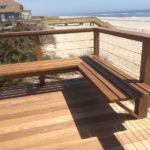
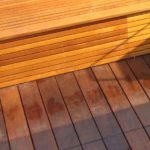
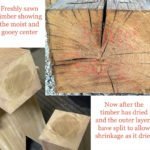
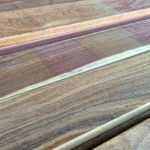
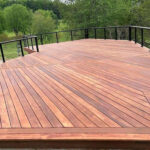
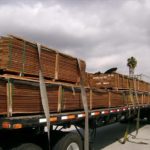


What stains and finishes do you recommend for the decking?
In general I don’t recommend stains but rather prefer to find a wood that matches the color I want then apply a good clear coat. Dyes and stains are essentially just dirt (pigment) applied to the surface which will inevitably fade and need to be refinished. This goes doubly when talking about an exterior project and triply (is that a word?) when talking about a high use exterior project like a deck. So I avoid adding colors and stick with a penetrating oil like Ipe Oil (which we sell) or Messmers or Cabot products. The key is that you use a penetrating oil and not a film finish which is eventually flake and peel/crack and have to be removed before re-coating. An oil will not have to be removed when refinishing and you can just reapply more on top of it.
Planning to use Ipe for benches as outdoor seating. With a Brazilian Hardwood (like Ipe or Jatoba) can sanding be done after oiling?
Of course. The oil is a penetrating finish and not a film finish that will sit on the surface. Some will even wet sand a freshly oiled surface as a way of filling the pores of the wood in order to get a high gloss surface. Though this is probably not your goal for outdoor furniture. Like most very dense hardwoods, oils will take time to absorb and you may need to wipe back the finish as it dries. This could interfere with sanding so it is imperative to make sure your surface is cured completely as partially cured oils will only gum up the sandpaper and leave an unattractive surface.
Thanks for all the great info. We are planning to follow your advice with a cleaner and brightener on our just-installed Ipe deck. We used a hidden fastener system (Ipe clips) but still have to plug a few boards that were screwed. We were planning to knock in the plugs until almost level with the deck surface, and then use a random orbital sander to smooth things. I have read some places that the sanded areas with take the oil differently and show the sanded areas… have you found this? Or is it better to give the entire deck a light sand to make sure the oil is even. Thanks!
A sanded area will look a bit different because you are abrading the surface and creating a scratch pattern that may be different from the surrounding area. It is best to go ahead and sand the entire deck lightly or at least blend those sanded areas on the pegs into the rest of the deck. Another option would be to flush the peg to the surface using a chisel and then you can skip the sanding entirely (unless the deck actually needs it)
Great site! Great info! I have a question- we recently received our ipe decking shipment, set it on racks to acclimate, and then oiled all 6 sides. We embarrassingly forgot to sand the material first prior to oiling (used ipe oil). The boards aren’t rough, but I want it to be great. Some of the grain was raised already, even before oiling. Would it be okay to sand the entire deck surface after installation, even though it had been oiled a few days before? I plan on using 80gril with my festool sander and vac. Your immediate response would be greatly appreciated. Thanks.
Yes I see no problem with that. The only issue I could see is if the oil has not cured and it could gum up your sanding pads. But what you are proposing is essentially annual or bi-annual maintenance of possibly sanding and re-oiling.
I recently purchased Red Balau 5/4×6 decking. Does it matter if the boards are sanded before applying the cleaner and brightener??
Thanks
No it doesn’t matter. In fact a lot of the decking boards sold today have already been sanded before delivery anyway.
I like the feedback. First time working with ipe, I noticed a greenish tint when I cut/sand. Will the cleaner treatment remove the tint? Looks like tannins or oxidation of some sort.
Ipe has all kinds of colors in it when you first cut and/or sand it. Greens, purples, etc. You are on point with the comment about tannins and oxidation. They are not tannins specifically but it is the oils and resins naturally found in the wood (generally called extractives). Nor is it oxidation, yet. It is the oxidation that will cause that color to fade and a little time in the sun will mellow it out and make it go away. However, the cleaner/brightener will speed up the process and create some oxidation that will break up the color compounds that cause those stray colors. Sorry, long way of saying yes.
We live in the north east and installed an iOS deck on the south side of our home several years ago. it has never been treated – our installer said no treatment or maintenance was required. Both the ipe deck and our teak furniture have turned grey (which is fine) but the color is very uneven. I have seen decks that are much more uniform which look much better. We will try the deck cleaner and brightener, but should we oil afterwards?
Color variance is part of buying wood. You will find some denser boards in every species that will be much darker, even after they go grey. Usually even this will even out given enough time. The cleaner and brightener will further oxidize the wood and blend this even more. If you oil you will bring back some of the original color but that may also highlight some of that density variance too.
Hi what stripper would you use to get my ipe deck back to original color
Depending on how much weathering has occurred a cleaner/brightener product may be all you need but ultimately sanding will always return the deck to its original color. Its not that you have to strip about a coating as it is the outer layers of the wood itself that oxidize and go gray. So you have to sand that away.
Great info here. Thanks! Our ipe is beautiful except the water stains from rain are very noticeable. Any advice on how to deal with them? Possibly a light sealant coat after using ipe oil? Thanks.
This will allow the water to bead up but be aware that any film finish you apply will be more difficult to maintain as you can’t just re-coat it without first sanding it back. Film finishes can flake and crack with too much water exposure too. It is a solution but go into it knowing that your upkeep may be more each year.
Thanks, Shannon. Don’t think we will go with the surface finish as a result of your comments.
Any advice on how to prevent or remove the water stains? Thanks again.
The same cleaner and/or brightener products that I talk about in this post will be effective at removing water stains. As far as preventing them you need to figure out where that water is coming from and causing it to pool. The stain is merely standing water that has had time to evaporate on the decking leaving behind any minerals and such in solution. So perhaps you have a depression in the decking that could be shimmed to encourage run off. Or the solution could be above by looking at the drainage off the house. Regardless, the goal will be to prevent the standing water in the first place.
I am considering using Ipe as a decorative accent as siding on part of my home. It faces a west exposure. I am concerned about the color bleaching out and what it will take to keep it brown. Would this be the proper product for this application or not? What kind of upkeep would it require to maintain the color and how often would it be needed?
UV will win all the time, the amount of exposure will determine how quickly the color fades. Annual oiling will keep the color fresh or you can extend that time frame by using a finish with more UV resistant solids in it. A spar varnish is the first thing that comes to mind but recognize that any varnish or film finish cannot be reapplied without first sanding back the previous coat. So this will significantly add to the upkeep. With Ipe it has the durability baked in to the species naturally so I would recommend re-oiling when the color starts to look a little dull.
Hello, not sure this thread is still active but I’ll give it a try! We just completed an install of an ipe deck and are waiting for the rain to give us a 48 hour break before applying oil. It is so gorgeous now, I can’t imagine it after the oil! My question is will metal deck furniture cause black spots or leeching on the wood? I have read that it can, and am buying new deck furniture and will avoid metal if needed, but so much of the furniture has metal legs even if it is wicker. Thank you.
I suppose this is possible with just about any wood. Ipe would be better than others when it comes to reacting with ferrous materials and most metal outdoor furniture (good stuff anyway) would be powder coated or have some kind of anti rust treatment done just to protect the furniture itself. But yes, prolonged contact could cause some staining on any species. I recommend you use plastic feet on the bottom of your furniture not only to provide some separation between the metal and the wood, but even more importantly to keep your furniture from scratching up the deck which will cause even more unsightly scarring.
Hi Shannon –
Thanks for keeping up this blog. You write well!
Question – what’s the difference between Ile Oil and Penofin Hardwood Penetrating Finsih? Which do you prefer, and why? Many thanks.
Peter
Ipe Oil is purely and oil that will soak in. It provides minimal protecting but helps to maintain the color. It needs to be reapplied annually but this easy as you just reapply. Penofin is also oil based but more dilute so it penetrates deeper into the wood. It also has wax in the mixture that will harden as it cures and helps to repel water very well. This adds a bit more of protection to the mix and will last longer that just an oil. In reality I don’t find a huge difference between the two finishes other than Penofin leaves a darker look because it penetrates deeper. I believe Penofin will last longer without reapplication. Most of our customers like Penofin for the initial look and the potential for a longer lasting color.
Thanks for the post. The challenge w Ipe Oil is that it dramatically effects the color of the wood. If I want to achieve a lighter more natural look to the ipe (i.e. not a deep wet looking red) then what is the best approach.
I think you could find several finishes that would give you a lighter look. Frankly a lot of the cheaper decker sealer type stuff out there would give you a more dilute and less resin finish. Probably some test boards would give you a good idea, but ironically the cheaper the product the lighter the look you will get.
We bought a house with an Ipe deck. This will be our first time refinishing it. It seems the previous owner used Messmers transparent.
I have pressure washed the deck using Behr deck cleaner ( at the time I did not know it was ipe). I sanded all of the railings and then applied Messmers. I think therailings turned out nice. Now I need to get the floorboards done. My question is concerning the sanding. It is over 500 sq feet. Should I sand the entire area or would spot sanding work? If so, what kind of sander would be best; a hand held or a large rented orbital? If you do yearly maintenance, does sanding need to be done every year?
Thank you in advance. You have been so informative.
Virginia
Unless you are trying to remove the old finish you shouldn’t have to sand it. Perhaps every decade or so a good sanding to refresh the surface would be a good idea but sanding is really to remove old film finish that won’t take a new coat of finish. If you use a good decking oil (like Messmers) then you just need to reapply over top as it is a penetrating and not a film finish. If you have particularly rough spots then spot sanding is fine but recognize that for a little bit anyway there will be a color difference where you sanded. This will go away with exposure but its something to be aware of if you spot sand a bunch of places. I would avoid sanding as much as possible for this reason.
Hi Shannon,
Your site is awesome! Quick question related to the above… we just installed a new ipe deck and feel like the surface is rougher than we expected. So for a new deck… to sand or not to sand? Do you have other ideas of how to make it more smooth? It’s not as rough as our old redwood deck but definitely not as smooth as other ipe decks that we’ve seen either. Thank you so much for all the great advice!
Joe
I think most new decks should have a sanding. Ipe especially because it is so hard can feel quite rough on the quartersawn boards. We will usually run our decking boards through the drum sander before shipping them out if there is a lot of quartersawn material. It isn’t always the case but sanding certainly won’t hurt it.
Great content here! My situation is a little more nuanced than the others, so I wanted to get your opinion.. Basic question is whether I’m better off just sanding the 5-year old deck (and my mistakes with it) than cleaning/brightening before applying a new oil? And if sanding is ok, what grit and how long do I need to wait between sanding and oil application? All details below…
– IPE deck installed spring 2014, left untouched at installation
– Washed then stained with Penofin Exotic Hardwood in 2015
– Started fading, so I wanted to try a different product, washed then stained using Defy Extreme Stain in 2017 (chose that product based on internet research, which I now think was a mistake)
– That product has performed worse in terms of color retention than the Penofin, so looking to go back to Penofin or anything else you’d recommend.
– Deck is less than 300 sq feet, and sits atop a roof in an urban environment, with no water supply (besides rain), eliminating the power wash option; even soap and water cleaning is annoying because I have to carry many buckets of water upstairs to rinse (unless I do it in the rain, which I don’t mind)
– Thus, taking an orbital sander to it is about the same effort as washing and trying to remove previous Defy stain in addition to a couple food oil stains on the deck (another mistake)… so would you just sand it instead? I’ve read some people say “never sand IPE!”, while others see it as sometimes necessary.
A deck is probably the harshest situation you can put wood through. A rooftop deck ups the ante even further with all that sun exposure and it will fade much quicker than another deck. That being said to keep the color you will want to reapply an oil at least once a year. When it starts to turn gray your best bet is sanding. Certainly brightener products can be a stop gap measure but based on your lack of water situation I agree that it would be a pain. Just sand it. The grit to use really depends on how gray the deck has gone and how much time you want to spend sanding. I would NOT go finer than 80 grit. 80 is what we sand our Ipe to when it leaves our yard. Any finer and you can actually burnish the surface a bit making oil absorption problematic. But considering the number of times you have applied finish over the years and the wax content of some of the finish you have used you will really want to get all of that off and back to bare wood. So I would start with a higher grit like 60 and get rid of all the previous “sins”. Then sweep it really well to get rid of all the dust. Finally you can reapply just a basic deck oil. Any amount of UV resistance built into the product really doesn’t mean much with that kind of sun exposure so I wouldn’t put too much effort into finding the perfect oil for your situation. The solution isn’t the finish you choose but applying it often.
We just installed an ipe deck around the pool. I don’t plan on oiling it. I like the natural grey color it turns and want o minimize maintenance for my children in the future. We live near the beach. Any need to or advantages to cleaning it with a product ? Was just going to let it alone Thanks for this site
I think you are fine to just leave it alone. Keep an eye on it over the years and you may just want to use a cleaner from time to time to clear off salt deposits and dirt and grime build up. Ipe is solid and hard enough that you won’t be getting the flaking and splintering that you might see from softer wood decks that really rely on the oil finishes to keep them moisturized.
I’m hopeful that this site is still active. We have an ipe deck that is 9 years old. We originally stained it a dark color (not sure if it is oil based or water-based sealer), but we are tired of the maintenance and would like to remove the stain and let it turn grey. We have a very large deck with benches around our hot tub. Can we just remove the stain using cleaner and power washing and then just let it go without using an oil sealer? It is quite expensive to seal/stain every year, and we have not done it in the past few years so there are stained areas and faded areas – it looks terrible. Any advice would be appreciated.
Much of the answer to this depends on what type of finish was applied to the deck originally. Certainly I would start with your plan of using the cleaner and brightener and a power wash to see what that does. You will then probably need to sand the deck to remove any stubborn spots left over. Eventually it will all even out and go grey but if you have a film finish you are likely to see flaking and peeling as well and that will need to be sanded off. A good sanding will cure all and certainly speed up the process or removing the finish.
Hey I just cleaned, brightened and oiled my Ipe Deck for the first time….it’s 1.5 old. The deck looks great but there appears to sneaker footprints in some areas (small dots in a random pattern). I didn’t step on the deck as I was oiling, but I did when I was brightening it. Could this cause that? How do I go about removing them? I was thinking of doing a light sand and re-oiling. Thank you
Its possible you had oil or grit or something on your shoes or just pushed more of the brightener solution into the wood fibers before applying the oil. You definitely want to make sure everything is cleaned off the deck before the oil goes on or things like you are seeing can pop up. Regardless the beauty of an oil finish is your plan of sanding and re oiling is all you need to do.
We just sanded and applied Ipe oil. We have a Big dog. After 12 or so hours, we let the dog out. He left quite a few foot prints. Any idea how to remove them. The finish is about 6 days old? Thanks a great sight
Some light sanding to remove the prints and then re apply oil. That’s all you need to do since oil isn’t a film forming finish that needs to be removed before reapplying. Depending on the local climate the oil can take more or less time to cure but you definitely want more than 12 hours. I would suggest at least several days of staying off the deck. Even up to a week to be sure if you live in a humid area.
Question on the initial treatment for new IPE deck installed late Fall 2018.
Before the initial oil application, do you recommand cleaning the deck or complete sandblasting.
I want to start the right way for my deck. Already the wood colour is very pale b3cause of winter and spring.
Looking forward to read your advice.
I would definitely recommend you clean the deck and even sand it before applying the oil. You wouldn’t wipe varnish onto a dirty dining table top and the deck should be treated the same way. Just following the advice here and using a cleaner and brightener treatment will go a long way to giving you a clean and ready surface for the oil. If you sand, most likely you can skip the brightener treatment but I would still clean the deck first as dirty and grime will just gum up your sandpaper and slow down that process.
My IPE deck has black spots, some caused by metal pots, some unknown. Sanding does not effect the spots. The entire deck has been power washed & does not have any finish at this point.Can you recommend how to remove these spots before I stain with either IPE Oil, Messmer oil or Penofin Harwood oil? Do I need to finish with any thing else?
the only way to remove the spots would be to sand past them. The staining from the metal reacting to the tannins in the wood is what caused them and it can run deep into the wood. You could just keep sanding until you get to the bottom of it but there is no way to tell exactly how deep it can run. So some additional sanding may help but there is no guarantee. I would try sanding and then use some kind of brightener product that will help to bleach away the rust spots. Again no guarantee it will remove them depending on how bad it is but it may lighten it. As far as finish, no particular finish will prevent or remove those spots.
What is the best way to remove both vertical and horizontal scratches from my ipe deck? I made the mistake of using a metal snow shovel last winter.
You will need to sand the deck back below the depth of those scratches.
Quick question sir. I am about to refinish my ipe porch deck with Messmer’s cleaner, brightener and UV Plus All Natural finish, that is what the previous owner uaed. My wife’s grandmother had a rock in her walkers rubber foot last year and made a scratch across the deck running about 10 feet horizontally across the boards the path she took from the steps to.the front door. Can I spot sand the scratch on each board over the 10 foot span or will that just make the stain absorb different and cause a 10 foot weird looking different colored streak? I like to avoid sending the entire deck, the rest of it is an excellent shape and smooth but I guess you got to do what you got to do. When I definitely need an orbital sander for sanding or can I use a vibrating palm sander? Thanks for your help.
Yes I would start by spot sanding away that scratch. I can almost guarantee it will look different from the rest of the deck when you apply the finish. But I can also guarantee that it will mellow in time and be less noticeable. It may even blend in perfectly over time. How long depends on how much sun the deck gets. The only way to ensure a perfectly uniform look is to sand the whole thing but you can start by just sanding the scratch and try that. If it doesn’t work its not like you wasted effort as the scratch will need extra attention before sanding the whole deck anyway. Orbital sander is going to be your best bet so you don’t add in sanding marks to make it look even more different from the rest of the deck. One other thing try to sand the entire deck board where the scratch falls. The gaps between the deck boards will serve to disguise any difference but if you only sand part of the face of the board it will be nearly impossible to hide that difference.
Hi. I have three very large decks with Ipe. We just bought the house and they are silver with small “crack” in the grain. I don’t think it has ever been treated. Due to the size of the deck I was going to rent a large sander. It’s not orbital, it looks like a large rectangle that vibrates I assume. The brand is an Essesx Silverline from our local equipment rental place. Here is the link:
https://sanrafael.allstarrents.com/equipment.asp?action=category&category=240&key=240-0065-0
Any thoughts on if this would be too aggressive? I’m worried about doing some damage.
Also after sanding, can I go right to oil without cleaner and brighter?
Thanks
Yes I think that would be too aggressive and like a floor sander you would have to keep it moving or risk taking off too much wood or creating a wavy surface. A random orbital sander would be your best bet for an already installed deck. And yes, no need to use a cleaner/brightener if you are sanding back to bare wood. Go straight to oil.
Hi Thanks for the reply. So I watched the video in the link again, and it does state that it is an Orbital sander. Were you concerned about damage if it was a drum sander? I can’t imagine sanding all my decks with a hand sander, so can you recommend a large orbital sander I may be able to rent or buy if you still feel this one may not work. Thanks again.
yes a drum sander removes a lot of wood very fast and the belt runs constantly in the same direction so it will leave grooves on the wood. If you use it you have to keep it constantly in motion and do not go over the same spot twice. An orbital sander won’t do this because of that random motion of the pad. I don’t really know of large scale orbital sanders, they would be very hard to control. You could use a combination of both with the drum sander for rough removal and then do a finish sanding with the orbital at a finer grit paper.
First, kudos to your driver who delivered my Ipe decking. He was awesome and very accommodating..
I plan to sand the entire deck once completed. What grit do you recommend sanding Ipe decking? 80? 120? I plan to use my Festool 6″ orbital sander.
I see you usually recommend using a citric acid cleaner before applying the Ipe oil but is that necessary if the entire deck has been sanded and is clean? If so, what cleaner product do you recommend as I sure don’t want to use the wrong cleaner.
Many thanks for all your helpful advice!
No there is no need to apply a cleaner if the deck has been sanded. You can go straight to the oil finish. 80 grit is fine, we tried sanding to 120 before and it doesn’t produce a surface that is really any better and in many ways made finishing a bit harder as the oil absorption was slowed down.
Hi Shannon,
we installed Ipe deck last November (2018). It has not been treated. Recently, we noticed small cracks in the decking. Is it normal only a few months after the installation? We also have water marks on the covered portion of the deck. Any advice?
Yes those small cracks (also known as checking) will occur in a very dense wood as it experiences uneven heating and cooling or moisture differential. You will mostly likely notice that those small cracks open and close through the seasons. Treating the deck with an oil will help to minimize this. Even if you like the weathered gray color, the oil won’t significantly change the color but it will act as a moisturizer of sorts and slow the moisture exchange in the wood that causes those checks to open and close. As far as the water marks, there are hundreds of variables that could be causing those. Mostly likely you have a drip from above and when water is left to evaporate on the surface, stains can be left behind. Again using an oil on the decking will help to minimize this. To remove it a cleaner and brightener product will scrub away the marks, giving you a fresh surface to apply an oil.
We had a Sapele deck installed with hidden fasteners one and a half years ago. The contractor had the wood routed for the grooves for the hidden fasteners at the lumber yard and then brought it to the job site and pre stained the decking with IPE Oil. He also treated the ends with a different sealant. It has been extremely wet over the last year here in southeast PA and now all the deck boards are cupped. I had another contractor look at the deck and he indicated the oil should only have been applied on the top, sides and in the grooves. He also said the grooves were deep and didn’t get treated with enough oil causing moisture to enter from the top and sides and this is what caused the cupping. Is this true and is there anything we can do to fix it?
The best course of action will always be to apply an oil on the entire board, not just the top or sides. When one face is left unoiled you get a moisture differential that will cause the boards to cup. However with all the rain the region has seen it is likely improper ventilation and drainage is the culprit for the cupping deck boards. The sealant on the ends was a good move and will have prevented end checking. Another thing to consider is how much gap was put between the boards and are they cupping or buckling as they run into the next board. There are a great many variables that could contribute to the cupping from wood that wasn’t acclimated properly before installing to the fact that hidden fasteners do not hold a board down as well as face screwing. Its hard to say what exactly would have caused your issue but you can sand the deck to level it out as long as the cupping isn’t so bad that it will sand through the tongue on the edges that house the hidden clips.
Hello Shannon, I have a large Garappa deck, about 3 years old. We love i, however, this year we noticed some dark black spots on one part of the deck – the sunny part, not sure if it is mold but could be. It looks like someone threw a few glasses of motor oil on it. It washed off with dish soap which surprised me. Of course I can scrub that area off and leave a large patch looking different than the rest of the deck which has grayed out nicely. Also, want to make sure it doesn’t come back if possible. Lumber yard is saying to use oxalic acid (missmers). Would I then have to do the whole deck? Any thoughts? I have pics if required.
It could be mold, it could be something dropped on the deck like sap or even bird droppings. Since it is in the sunny spot, whatever it is was likely “baked in” quickly making it tough to remove. I’m not sure you need to take any extra measures to prevent it from coming back. Especially if it was removed so easily with soap and water. You can use a deck brightener (the oxalic acid) but you will want to do the entire deck. There is just no way to do only a part and have it come away looking the same as the rest of the deck.
What causes sapele deck boards 1×6 and 1×3 to cup? Our deck is less than two years old and was treated with IPE oil before being installed with hidden fasteners. Is sanding the only way to address this problem? Do we have to be concerned about thinning the deck boards on the edges where the grooves for hidden fasteners are? We appreciate your thoughts.
If finish is not applied to both top and bottom of the deck boards you can get a differential in moisture and a resultant cup. If the deck doesn’t have proper ventilation underneath the differential from the top to bottom can cause cupping. Decks in direct sunlight all day long will especially be prone to this. To address it you do need to make sure you have space below your deck for proper ventilation and you can apply finish to the underside to help straighten out the cup. This doesn’t always work but it is worth a shot depending on how long the deck boards have been cupped. Finally you can sand out the cup and yes it will thin the material around the groove but I suspect you could remove the cup without weakening it substantially. In the end if cupping continues due to the environmental conditions of your deck I would suggest face screwing instead of hidden fasteners.
Hi Shannon, great information. Just reading through your responses and wanted to confirm a couple things on the new ipe deck we installed:
1. Let the deck weather for 6-8 weeks before cleaning, sanding and oiling the deck
2. If we use a cleaner and a brightener before sanding, is that relatively useless? I can see from your previous comments that there is no need to use a cleaner before sanding but I had purchased a cleaner and a brightener so was wondering if that provides any value or just wait till annual maintenance to use them?
3. If cleaning and brightening is not required, we should just sand (after 6-8 weeks) using 80 grit and then wait 48 hours and apply oil?
Thanks so much
1. No I think you HAVE to wait to oil the deck. I would seal the ends of the boards immediately and oiling it now will help to slow down any acclimation and let the boards settle into equilibrium with the surroundings easier.
2. No need to use cleaner and brightener if you are sanding, that is a maintenance product that will hopefully allow you to avoid sanding in the future.
3. Again waiting to sand isn’t a bad idea but it depends on why you want to sand the deck in the first place. Is it rough, uneven? Waiting to sand will allow any movement in the new deck to hopefully settle down and then sanding can level it out. Sanding will expose fresh wood and additional movement is possible so I would apply oil right after you sand to slow down that moisture exchange.
The thing you have to realize is decking is one of the harshest environments we can put wood into and there are many variables at play so its hard to say there is a definite playbook that works in every situation.
hello
thanks for the info but i seem to be leaving with confusion so please answer my questions. thanks so much
I will be laying IPE on my west side and south side facing decks. i live in the mountains of Colorado so there is much temperature changes dryness sunlight and heat as well as cold temps in the winter with standing snow and ice. I understand that i should oil it before installing, all sides and to seal the end cuts? i was going to use IPE because i understood it to be a maintenance free wood. I don’t mind the graying effect but i am afraid of the cupping people talk about. do i need to oil and should i do all sides before installing in this climate? thanks for your input and advise
First I don’t think “maintenance free” exists in any product. If you let your Ipe go gray then there is a lot less maintenance required but even then every 2-5 years a cleaning or even sanding is a good idea to keep the deck in good shape. In your climate this may go even longer due to the dryness of the Rockies. If you want to avoid cupping then don’t use a hidden clip system and instead face screw your deck boards. This will resist the cupping much more than hidden fasteners. Still go through the oiling and end sealing process but that is to allow the boards to ease into their new environment. The boards will move regardless and face screwing while it doesn’t prevent movement (a bad idea) will restrain the movement and keep the boards pretty flat. That being said with dramatic uneveness in heating and cooling from one side to the other some cupping can occur in the first year and sanding to flatten after a year may still be necessary. Each install will be different and rely mostly on the environmental conditions. With your dry climate many problems will be avoided however as so much of them are moisture related.
In the preliminary stages of replacing an original porch on a 100+ yr old home. Located in PA it will be exposed around the edges to all 4 seasons. There is a roof but it is not enclosed. Thinking of using tongue and groove Camaru ( Brazilian Teak). Is tongue and groove the correct product for a non enclosed porch. This is what currently is on and survived 100+ year but it has been painted many times consequently construction & materials was made to last during that time.
How should the new porch be treated if Camaru is a good option; oil or water seal or both?
Thanks for your help.
When the porch is covered you can get away with a T&G floor since water drainage isn’t as big of a problem. Still maybe I’m being overly cautious but drainage is still something to think about and hopefully the roof has an overhang or gutter system. The fact that the current floor has lasted so long is a good sign that any material you put down will perform just as well. Cumaru is a great product, much like any tropical decking, for rot resistance and weathering the elements. I think you will be very happy with it. I would stick to a similar profile as the material you are taking up, specifically the face measurement since that performed so well. Yes using a deck oil/sealer is a good idea unless you just want the material to weather to gray faster. Still I would recommend a deck oil to help slow the acclimation of the Cumaru in its new environment.
Hi – We are almost finished installing a new Ipe deck. We are in Northern Virginia, used hidden clip fasteners for the main deck, and screwed and plugged the edge boards, steps, and railings. We want the Ipe wood to go naturally gray. There are a few areas that need to be sanded (a few areas of minor rough finish and some minor scratches). After that we are cleaning all the new Ipe wood in the deck, rail and stair with Penofin 1st step prep, and then finally applying Wisecoat hardwood deck sealer to the underside of the deck and all top surfaces.
I have two major questions:
1. Is there any change you would recommend to how we are planning to prep and finish the deck, knowing that we want it to go gray and last forever?
2. What is the best type of maintenance and frequency of recommended care that we should expect to perform to maintain a naturally gray Ipe deck that we want to enjoy far, far into the future?
I love the detail you provide here on your site, and look forward to the guidance you will give us as we embark on our first Ipe deck. Thanks!
No changes, I think you have the right plan in place. As far as maintenance, with letting it go gray you have much less to think about. The biggest issue with the humidity we have here in the East is that lichen and fungus and such can pop up or the occasional water stain. Usually those can be dealt with locally as they pop up but a good idea is to use the cleaner and brightener path I talk about in this article once every 2-3 years or sooner if you see spots popping up. I don’t think you will have to go so far as sanding however.
My staCk of ipe siding has accli mated for two weeks now. I’m getting ready to oil all six sides. My questIon is once oiled can I restack with stickers or do I have to worry about the stickers leaving marks on the ipe. The install will take a few days .
If you have let the oil dry for about 24 hours you shouldn’t have an issue with the stickers leaving a mark on the oiled Ipe. More importantly if this is siding you are talking about I’m not sure it is necessary to keep the Ipe stickered since it will just be fastened to the wall and in an exterior application where acclimation isn’t as serious an issue as it would be for an interior application or even as a decking application.
Hi there,
Thank you for all of this great information. I think I know the answer after reading through all the comments, but wanted to double check. We just had a cumaru deck installed (JUne) along with cumaru faced retaining walls. The decking is so dirty from all the construction, plus pencil marks, some scratches and sap from our Tree. The plan was to sand and then clean, brighten and apply oil. From reading, it sounds like we may not need to clean and brighten if we sand First. That would be great.
Questions:
1. DO we need to clean first then sand or is cleaning and brightening not necessary if we are sanding? Do we just wash off Dust, let Dry and Oil?
2. IS 80 Grit with an orbital sander the best way to sand Deck and Stairs? What about vertical retaining walls?
3. I am looking to use Messmers or Penofin products. Any Preference between the two for CUmaru?
Consider sanding the nuclear option. If you do that then nothing else is needed because you are removing all the dirt and sap and the outer layers of the wood itself that have darkened due to sun and oxygen exposure. So sanding is the ultimate brightener. Also no need technically to clean the deck first before sanding but I do think the work will go a bit faster if you can wash away the dirt so you don’t spend time sanding dirt through to the wood. Once the sanding is done (yes 80 grit orbital application is fine) give it another wash to remove dust and dirt. My personal preference is for Messmers but honestly both Penofin and Messmers are outstanding and its very very close race. Personally I find Messmers gives you a closer to the real wood look while Penofin’s line changes the color a bit more. But again that’s a personal preference and if you want to unify the color Penofin is the better choice.
Im reDoIng an ipe floor. I know this is a deck website but the home owner wants it sanded and then once sealed for it to look as if there is nothing on the floor as in finish. Is there a wood bleach specifically made for ipe or a process to lighten the floor so once fInish is appliEd it looks as if there is Nothing on it. Ive tried oil and water based products and a monacoat pure. Still she is Unhappy. Wel not unhappy. Im jumping through hoops to figure it out for her. Please iF there
Is a product you know of please help. Thank you for your assistance in advance.
This is a tough one because as you know flooring takes a beating and the finish adds a fair bit to its durability with a thick, heavy film coat or urethane or other resin/varnish based product. Certainly water based will give you more true to color look but you are still laying down multiple film layers. Possibly consider the OSMO line of products. I have used the PolyX product a few times specifically because of its close to the wood look. This is a hard wax and oil blend and its does its job specifically because of the need to apply fewer coats. Similar to the Rubio MonoCoat idea. But here again I’ve only used it on furniture and I’m not sure I would be keen on using it for flooring due to the higher durability needs. You might try some of the WoodKote products. I’ve seen them used to great effect for bleaching darker woods like Walnut. This may go too far as I’ve seen nearly white woods resulting from it. Still they have different products and some dilution may help with some test boards. In the end since Ipe is so hard to begin with and already an oily tropical wood you don’t need to apply an oil or penetrating finish that will just darken the wood. What you want to do is seal it with a top coat to prevent additional absorption of material. So perhaps OSMO as a base coat then a more traditional flooring finish over top of that. I’m sure I don’t have to tell you to make some test boards as the adhesion of a hard wax product and something like Poly I’m not sure about. Sorry I can’t give you a specific product recommendation but hopefully this helps.
Hi shannon,
We spoke recently about my Ipe roof deck in Chicago that was damaged by CONTRACTORS. To reFresh, they spot sanded the damage/scrapes, power washed and left marks from the power washer, and then applied BenjaMin Moore Arborcoat, Premium Exterior, Classic Oil Finish for deck and siding, translucent. My deck was left natural and had been gray, after oil application it has a reDdish/brown color.
As the power wash marks and Cross-grain sanding of the SCRATCHED area are still visible, the contractor is coming bAck to fix it again. I shared this site and here is what they are proposing:
-Apply a oil stain remover to the deck boards and scrub the deck with stiff bristle brushes
-Rinse the deck to remove the remover and oil but the deck is not to be power washed
-Sand the entire deck with random orbital sanders and 60 grit paper
-Clean all the saw dust off of the deck
-Sand the entire deck with random orbital sanders and 80 grit paper
-Clean all the saw dust off of the deck
THE OIL WAS APPLIED ON FRI, 11/6. My QUESTIONs:
1) is the oil stain remover W/bristle brush NECESSARY, could that have any negative impact on the Ipe? Or is it an appropriate step to takE?
2) any tempErature considerations for either the stain removal process or the sanding?
Thanks for your insight and help,
Jessica
I don’t know that it is necessary but it can’t hurt and is probably a good measure just to be sure everything is off the deck before sanding. It will make the sanding go a little easier as any stains et al could just gum up the sandpaper and even create burn marks. No temperature concerns for sanding. I don’t know too much about the remover they are using but that shouldn’t be a problem either.
Thank you for all yOur help! They’ll be using Benjamin Moore Remove and then Brighten.
https://www.benjaminmoore.com/en-us/interior-exterior-paints-stains/product-catalog/espp/exterior-stain-prep-products
They’ll let the deck dry out for a few days and then sand. Giving them the green light and looking forward to see how it Goes.
Shannon, thank you for maintaining this blog! I recently stained my ipe deck for the first time. Similar to the post above, I used the Benjamin Moore restore and brighten process. Because of frequent rain in the northeast this summer, it was two weeks before I could stain the deck after that prep. In calling the stain company, they told me that timeframe was too long not to repeat but said it would be more simple to do a mix of bleach, water and soap. Not wanting to do what seemed to be a caustic process with the restore product again, I opted for the bleach water mix. However, in staining the wood, an odd thing then happened. The stain didn’t really “take” and looks, well, almost bleached out. In other words, I think the bleach water mix may have not gotten out of the wood and is now interacting with the stain. I am very concerned. I’m ok with it looking like this for a year and addressing the right way next year after the stain fades. However, I am concerned that I did permanent damage and wondering whether the bleach will dissipate from the wood over time? I’m frustrated with myself and with what I think may be inappropriate instruction from the stain manufacturer. I would greatly appreciate any suggestions or advice.
No I don’t think you have done permanent damage to the wood. Depending on how strong you made your bleach and water solution it would take a fair amount of rinsing to get the bleach off the wood entirely. I don’t think the advice they gave you was wrong but I would have made very sure to rinse thoroughly and let the deck dry completely before applying the deck finish. The residual bleach would have reacted with any pigment in the finish and this is what has most likely caused your issue. By next Spring you won’t have any further issue. In fact by the time you are reading this you probably won’t have any issue if you want to sand the deck and reapply. I don’t know what kind of finish you used and that will change how you prep and reapply but if you are fine with it now, no need to do extra work. Rest easy that next year you should have no problems. Just give the deck a thorough washing and time to dry before applying a new coat.
Do you have any sugges For oxidation Rings from galvan nails? We bought a house with a painted deck but as we were refinishing noticed it was ipe, so stripped the paint off exposing the galvanized nails which have SUBSEQUENTLY started to blacken the wood aRound every nail…a spotted mess! We have heard muriatic acid could clear it up, but do you have any other recommendations?
I haven’t personally used muriatic acid for anything but etching concrete prior to an epoxy coating. I’ve heard it works as well but it certainly won’t prevent the stains from coming back. Ipe along with many woods will react to ferrous fasteners and stainless or acid proof screws/nails should be used. I would try something a bit less caustic as first like a deck brightener that relies more on bleach and oxalic acid to do the job first. If nothing else it will clean up the entire deck and make look better. If you still have some staining around the nails then spot treatment with muriatic acid can be your next option. The other issue is the density of Ipe is so high that getting a surface treatment to penetrate deeply to remove the long set in staining can be tough.
OUR IPE deck was stained in the last 3 months. But it now has water stains from condensation. It still has it’s deep color. What do you recommend to remove the water stains without having to restain.?
Start with soap and water and a stiff bristle brush. Those stains are just minerals left behind from the water that has evaporate and then baked in with the sun. If they persist you can use a deck brightener which relies a bit more on bleach to remove the stain. The issue there is that it is best to do the entire deck then as spot application of the brightener will be obvious and not match the rest of the deck.